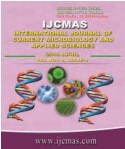


 National Academy of Agricultural Sciences (NAAS)
National Academy of Agricultural Sciences (NAAS)

|
PRINT ISSN : 2319-7692
Online ISSN : 2319-7706 Issues : 12 per year Publisher : Excellent Publishers Email : editorijcmas@gmail.com / submit@ijcmas.com Editor-in-chief: Dr.M.Prakash Index Copernicus ICV 2018: 95.39 NAAS RATING 2020: 5.38 |
Developed model is based on digital image processing techniques under RS-GIS domain, in which conversion of Intensity, Hue and Saturation to RGB image of SWIR, NIR and red spectral bands has been applied for the signature capture of clay soils. To achieve this target, spectral enhancement process was initiated by using of AWiFS data (May, 2015). Clear cut demarcation of clay soil patches from surrounding was observed in blue tone of the converted RGB image. Out of the total geographical area, the maximum coverage of clay soils was observed in Mokama (12.79%) followed by Pandarakh (11.12%), Ghoswari (10.48%), Pali (10.46%) and Bakhtiyarpur (9.90%) blocks. However, in context of physic-chemical status of soils, the clay content varied from 57 to 66%, soil pH neutral to slightly alkaline (7.02.-8.62), EC normal, available nitrogen low, available phosphate medium and available potash medium to high were recorded. Research findings may be helpful for the confirmation of heavy texture soils under low land topography of Bihar.
 |
 |
 |
 |
 |